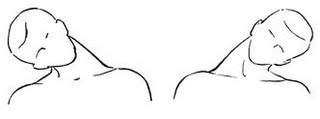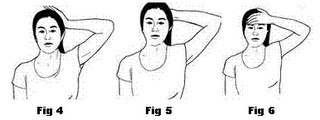S.Bamila
M.V. Centre for Diabetic Foot Care, Podiatry, Research & Management
Cervical spondylosis is a common cause of chronic neck pain. It occurs when there is abnormal wear on the cartilage and bones of the neck (cervical vertebrae).
The most common cause is ageing. By 60 years, most women and men show signs of cervical spondylosis.
Other factors that can cause spondylosis are:
* Not exercising and being overweight
* Lifting heavy weights or a lot of bending and twisting
* Previous neck injury (often several years before)
* Earlier spine surgery
* Ruptured or slipped disc
* Severe arthritis
* Small fractures to the spine due to osteoporosis
* Diabetes
* Faulty posture:
-slouching or sitting incorrectly on soft chairs and couches
- bad back and neck posture from sleeping on a soft mattress
- lifting weights incorrectly
* Malnutrition
* Stress and strain from sitting for a long time
* Emotional problems leading to muscle cramping
Symptoms
* Severe nagging pain spreading to both the sides of the shoulders, back of the neck, the collar bone and head. Pain in arms and fingers. At times, chest and throat too could be affected.
* Acute or chronic stiffness, leading to partial or complete loss of movement.
* Numbness and tingling or complete loss of sensation on the affected side.
* Headache
* Giddiness
* Weakness of muscles in the arm or hand.
* Loss of balance (less common)
* Loss of control over the bladder or bowels (if there is pressure on the spinal cord)
Treatment
Most symptoms respond to basic treatment such as:
* Rest - This may range from reducing normal activities to complete bed rest for three to five days.
* Neck collar or brace - this restricts neck movement so that the shoulders take the weight of the head.
* Traction - in some cases intermittent neck traction may be recommended for one to two weeks. This may be done in the hospital or at home.
* Pain relieving drugs /Pain-relieving injections
* Physical therapy /yoga work on improving posture. In cases of severe or chronic pain or loss of movement, surgery may be recommended.
* Chronic neck pain is also sometimes associated with anxiety and depression which may also need to be treated.
Exercises for Neck Pain and Spondylosis
Here are basic stretches and exercises that can be used by almost everyone in pain. However, always consult your doctor before beginning an exercise plan.
Exercise for 10-15 minutes a day. Do the entire routine for maximum relief.
1.Extension and flexion is especially helpful for stiff back and neck.
Flexion
Lower your head and bring it forward so that the chin touches the chest and your face is staring straight down at the floor. Do this slowly five times.

You can also add gentle pressure by putting your hands behind your head to hold the end position.
Extension
Allow the head to go back until you look directly at the ceiling.
Caution: Don’t do this movement fast or forcefully as it forces all the small joints at the back of the neck into an extreme position. 
2. Rotation
Turn your head slowly round to one side until it cannot easily go any further.
Caution: Do not go from one side to the other in the individual movements or roll your neck about.
Hold your neck at the end of the movement for a few seconds. Do this five times to one side and then repeat on the other side.
Don’t do this if you feel dizzy. Dizziness, especially in older people, might mean that the blood vessels in your neck are being squeezed by the position.
3.Side Bend
Side bends increase your side-to-side flexibility. Start by lacing your fingers together and pointing your elbows outward. Bend at the waist, tilting your body to one side as far as you can. Then bend your head and neck in the same direction. Repeat on your other side. Repeat this exercise 10 times.
4. Sit And Twist
This exercise increases the flexibility of your entire spine. To begin, lace your fingers together and point your elbows outward. Slowly and gently twist at your waist, rotating your head and neck to the same side. Repeat toward the other side. Repeat this exercise 10 times.
5. Side / Lateral flexions (Tilt)
Facing forward try and tip your ear down towards the same shoulder.
6. Strengthening exercise.
Reach your right arm over your head so that your palm is on top of your skull, your fingers resting just above the left ear. Allow the weight of your arm, along with light fingertip pressure, to gently bend the head toward your right shoulder (fig.1). Check to make sure your shoulders are still relaxed. You should be looking forward. Hold the pose for 30 seconds.
Move your fingers toward the back left corner of your skull, this time allowing your head to bend forward and to the right, about 45 degrees in front of your shoulder (fig.2). Hold for 30 seconds.
Now place your fingers at the back of your skull and gently pull your head straight forward, toward your chest (fig.3). Hold for 30 seconds. Switch hands and repeat the stretches in reverse order: Pull forward, then 45 degrees in front of your left shoulder, and finally directly over your left shoulder. Do not push your head backward.
Place your hand against the side of your head. Try to bring to your ear to your shoulder, resisting the motion. Repeat this exercise on the other side. Hold each position for 5 seconds and when finished relax slowly. Repeat this exercise on the other side. Hold each position for 5 seconds and when finished relax slowly. Repeat with your right hand on the right side of the head. Do the same exercise, using either hand, with the back of the head (fig.5) and the forehead (fig.6)


Preventing Cervical Spondylosis
* Exercise regularly and don’t engage in activities that place pressure on the head, neck, and shoulders.
* Low-impact activities, such as swimming, walking, or yoga are ideal for the health of the cervical spine.
* Maintain good posture while standing, sitting, working at the computer, driving and sleeping.
* Do not hold the head in the same position for long periods. Take regular breaks when driving, watching TV or working on a computer.
*Use a seat belt in a car and avoid activities that strain the neck to protect the neck from injury.
*Avoid bending forward suddenly.
*Avoid nodding head movements.
*Make lifestyle modifications.
REFERENCE:
1. http://cervicalspondylosis.com/exercises_for_cervical_spondylosis.htm
2. http://www.ncbi.nlm.nih.gov/pubmedhealth/PMH0001472
3. http://www.patient.co.uk/health/CervicalSpondylosis.htm
Welcome to M.V Hospital for Diabetes, established by late Prof. M.Viswanathan, Doyen of Diabetology in India in 1954 as a general hospital. In 1971 it became a hospital exclusively for Diabetes care. It has, at present,100 beds for the treatment of diabetes and its complications.
Wednesday, December 14, 2011
Cervical Spondylosis in Diabetes
|
Bookmark this post:
|
|
Subscribe to:
Post Comments (Atom)







nice services
ReplyDeletecan any1 plzz tell me the relationship between cervical spondylosis and diabetes ??????????//// plzzzzzz
ReplyDeleteThanks.There is no relationship
Delete